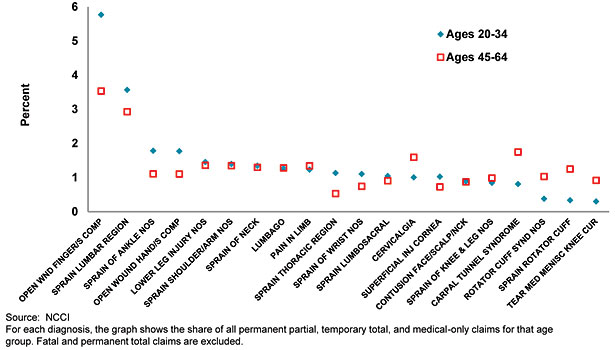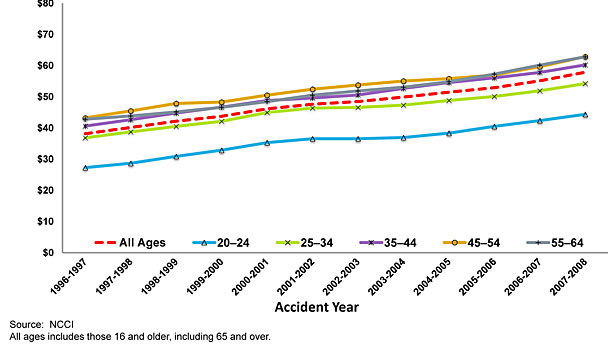Employee Matters
Workplace injuries: Is 35 the new 65?
New study shows a seismic shift in the definition of “older workers” on the job, and shows that the workers’ comp game has changed.






The workforce is getting older. People are retiring later in life than ever before.
This trend has been a major concern for those in the health and safety field because the common knowledge has been that older workers are more prone to suffer very expensive injuries.
However, new research from the National Council on Compensation Insurance (NCCI) has cast doubt on this conventional wisdom, or at the very least potentially changed the definition of “older workers”.
NCCI studied different age groups and the rate at which they get injured. They found younger workers (under 35) had substantially more cuts on their fingers, and older workers (over 35) suffer more cases of carpal tunnel and more cervical injuries, although the numbers are startlingly similar.
So, that quiets the argument about the aging workforce causing more injuries, but what about cost? The research shows that there is a substantial cost difference between younger and older workers, but the split isn’t necessarily where you might expect it.
Workers between the ages of 20-24 create much lower costs (and fewer days out), but once workers reach 35, the costs of their injuries are very similar to older workers. What does this all mean?
To start with, it now largely redefines an “older worker” as someone who lived through the age of disco rather than someone who grew up listening to Elvis. In other words, workers over the age of 35 — not just those in the traditional “over 65” group — are now being classified as an “older workers.” Additionally, this data should prompt businesses to strongly focus on the things that can reduce injury costs for their entire workforce.
Start early, reinforce often
Injury prevention for employees should begin before they even become employees — during the hiring process.
Start with a written functional description for the position that is open. Once that is complete, it is critical that the candidate you select be given a conditional offer of employment. This document is a bona fide job offer with the caveat that you can withdraw the offer if they are physically or mentally unable to do the job with reasonable accommodation.
Once this is complete, have the candidate go to the doctor and complete a post-offer, pre-placement medical questionnaire. Having this completed allows a physician to ask questions relevant to the job and to let the employer know whether or not the candidate is fit for the job.
If they are, it’s time to get started. If not, you’ll have to find another suitable candidate.
Once an employee is on the job, it is critical that they are always mindful of how they are doing their job. Far more injuries are caused by unsafe acts by employees than any unsafe conditions in their workplace.
Employees who feel rushed are more likely to set safety aside in favor of meeting a deadline, and those decisions result in accidents that could have been prevented.
When you take all these steps and have a workforce that is fit for work and doing their job safely, then the focus turns to what happens when an accident does happen and an employee is injured.
Employees must know before they get hurt that, when they suffer an injury, they should report it promptly to the appropriate person. Immediate injury reporting is a key to keeping injury costs as low as possible. Studies have shown that the costs of an injury go up when there is a delay in reporting. Make it your policy that any employee injury is reported before the end of the shift.
Get support
After the injury has been reported, getting the proper treatment is key.
Your business should have a relationship with an occupational medical provider in your area. You can find board-certified occupational doctors on the Web at acoem.org. Even if there isn’t an occupational medicine specialist in your town, you can develop a relationship with a physician and send your injured employees to that doctor.
The goal of having a relationship with a workers’ compensation specialist medical provider is to ensure that the doctor knows your business and the physical demands under which your employees perform. They also should have a good knowledge of the transitional work that you have available.
When a doctor knows you will accept an employee back to work on transitional duty, they are far more likely to send them back to work rather than send them home to sit on the couch and watch infomercials for attorneys prompting them to sue their employer.
When an employee is at work, they are more likely to work hard to get back to their full duty position. This process not only gets employees back to work more quickly, it also reduces the amount of money that the insurance company spends on your employee injuries, reducing your experience modification rate (EMR) and therefore your workers’ compensation insurance costs.
Without a doubt, the workforce is getting older, and we need to be mindful of accommodations that older workers may need today that they didn’t need before. However, this new research from NCCI should sharpen employers’ focus on what can drive down injury rates and costs — hiring the right people, training them to do their jobs safely and making sure accidents are reported immediately and treated by a skilled physician who will send them back to work, rather than send them home.
If employers follow those steps, having older, experienced workers on the payroll can be a great asset rather than a potential liability
Looking for a reprint of this article?
From high-res PDFs to custom plaques, order your copy today!










